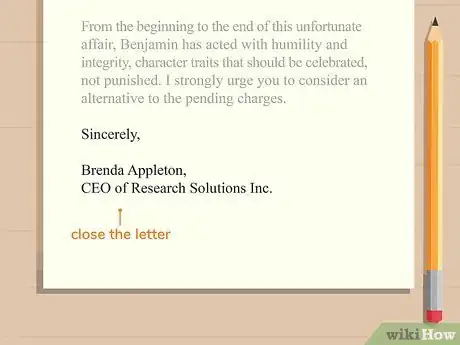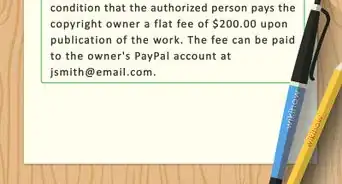This article was co-authored by Clinton M. Sandvick, JD, PhD. Clinton M. Sandvick worked as a civil litigator in California for over 7 years. He received his JD from the University of Wisconsin-Madison in 1998 and his PhD in American History from the University of Oregon in 2013.
wikiHow marks an article as reader-approved once it receives enough positive feedback. This article received 23 testimonials and 83% of readers who voted found it helpful, earning it our reader-approved status.
This article has been viewed 1,528,417 times.
There are occasions when you may find it pertinent to write a letter to a judge. You may believe that what you have to say can impact how a judge approaches the task of sentencing someone you know. Knowing what to include in your letter and how to say it can determine how effective the letter ends up being. That is why it is important to format the letter properly and make sure that the content of the letter is effective and not detrimental to the defendant's case. Do not communicate with a judge if you are a party yourself to a criminal trial because it is generally illegal to do so.
Steps
Setting out the Letter
-
1Write the letter on letterhead, if possible. You want to make sure that the letter looks as professional as possible. One way to do so is to write the letter on professional letterhead, if possible. This letterhead could be the official letterhead of your place of work.[1]
-
2Date the letter. At the very top of the letter, put the date on which you write the letter. The date should be left-justified.[2]Advertisement
-
3Address the judge with the proper address and salutation. Below the date, provide the official name and address of the judge. This will normally be the courthouse in which she presides. For example, you may write:[3]
- Honorable [Judge’s Full Name], United States District Judge, 11 Commerce Street, Dallas, TX 75242. This name and address should be left-justified and written out as you would an address at the top of any letter, below the date.
- Below the name and address of the judge, provide the appropriate salutation. The appropriate salutation for addressing a judge is “Your Honor” or “Dear Judge [Judge’s last name].
-
4Name the defendant. You should write down the defendant’s first name at the beginning of the letter. This can go in the first sentence of the letter or separately between the address and the salutation as follows:[4] RE: [Defendant’s Name].
Writing the Content of the Letter
-
1Write who you are and what your profession is. In the first paragraph of the letter, you should begin by introducing yourself and saying what your profession is. Do not be modest about your credentials, particularly if you are held in high esteem in your community because of your professional or private work. Highlighting your credentials shows the defendant’s reputation and relationships in the community in a positive light. For example, you can write: "My name is ____________________, M.D., a practicing physician and Chief of Staff of ________ Medical Center in ________________, Florida."[5]
-
2Explain how you know the defendant. Also in the first paragraph, highlight your relationship with the defendant by stating what capacity you know the defendant in. Write how long you have known him and highlight the positive aspects of your relationship (e.g. love, friendship, respect). For example, you can write: "I have been a lifelong friend of ___________. Our families were friends before our births. _______ and I were friends during childhood and have remained close after high school, college, and during our adult lives. I know ______________ about as well as any person other than his immediate family could. I know him to be an industrious, hardworking, family man who is community-minded and other-centered. He has worked hard in his church family and, in fact, worked very hard in his job as __________________________."[6]
-
3Provide a general statement of support. In the second paragraph, write a general statement of support. Let the court know if the defendant has been candid about his legal problems and has shared those problems with you. If the defendant has admitted his wrongdoing to you, tell that to the judge, as this is seen as a positive. Also say if you are able to help the defendant after his legal troubles are over, perhaps by offering him a place to stay or a job.[7]
-
4Write a statement on the defendant’s character. In paragraph 3, write a statement on the character traits of the defendant. Highlight positive character traits such as honesty, courage, love, or state why you think the defendant is a family man, a hard worker, or a good parent. Always try to provide examples of how the defendant depicts these character traits and offer any stories or personal experiences you have with the defendant that further highlight these positive traits.[8]
-
5Add additional information. You may add anything else that you feel will be helpful to the defendant. Make sure the additional material is both concise and informative.[9]
-
6Write the conclusion. In paragraph 4, conclude the letter by explaining to the judge in your own words that the defendant understands that he has done wrong and expresses regret at his actions. Also state that the defendant would like to learn from this experience and move forward with his life. For a request of leniency, state why you believe that society would not benefit from sending the defendant to prison and how all the parties involved would suffer from such a result. You can write, for example: "I believe that an extended prison term will serve as a tremendous hardship for his wife, who will bear the responsibility of trying to repay the costs of the court case and restitution. I believe that ________’s daughters, one of whom has assumed a large portion of the restitution cost, will be tremendously adversely affected if he is required to go to prison."
-
7Avoid improper remarks. You should not make any disparaging comments about the judge, prosecution or other parties involved in the case. Focus on the defendant’s positive traits while at the same time not diminishing the significance or seriousness of the offence.[10]
Sample Letters
Warnings
- Do not communicate with the judge if you are a party to ongoing judicial proceedings, as such communication is generally prohibited as “ex parte communication.”[11]⧼thumbs_response⧽
- Do not send your letter directly to the judge. Defense attorneys prefer that their clients’ friends and relatives send the letter to the attorney first so that the attorney can read over the letter and confirm that there is no information in the letter that may be detrimental to the defendant’s case.⧼thumbs_response⧽
References
- ↑ https://www.legalaid.vic.gov.au/find-legal-answers/going-to-court-for-criminal-charge/writing-character-reference
- ↑ https://thelawdictionary.org/article/best-way-to-write-a-professional-letter-to-a-judge/
- ↑ https://thelawdictionary.org/article/best-way-to-write-a-professional-letter-to-a-judge/
- ↑ https://thelawdictionary.org/article/best-way-to-write-a-professional-letter-to-a-judge/
- ↑ https://www.legalaid.vic.gov.au/find-legal-answers/going-to-court-for-criminal-charge/writing-character-reference
- ↑ https://www.legalaid.vic.gov.au/find-legal-answers/going-to-court-for-criminal-charge/writing-character-reference
- ↑ https://thelawdictionary.org/article/best-way-to-write-a-professional-letter-to-a-judge/
- ↑ https://thelawdictionary.org/article/best-way-to-write-a-professional-letter-to-a-judge/
- ↑ https://www.lawaccess.nsw.gov.au/Pages/representing/lawassist_readingwritinghome_wysk/lawassist_letters_wysk/lawassist_letters_courts.aspx
About This Article
To write a letter to a judge, start by introducing yourself and stating your profession. Then, explain how you know the defendant you're writing about. In the second paragraph, offer a general statement of support by letting the judge know you're aware of the defendant's wrongdoing and you're still willing to support him. In the third paragraph, highlight the defendant's positive character traits to show the judge they're a good person. Finally, conclude your letter by stating why you believe the defendant doesn't deserve a harsh sentence. To learn more from our Civil Litigator co-author, such as how to address the top of the letter, keep reading the article!












































































